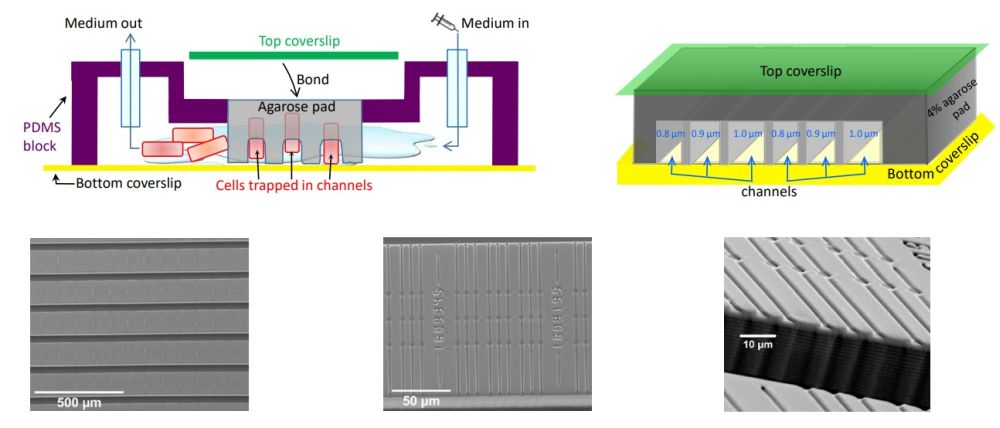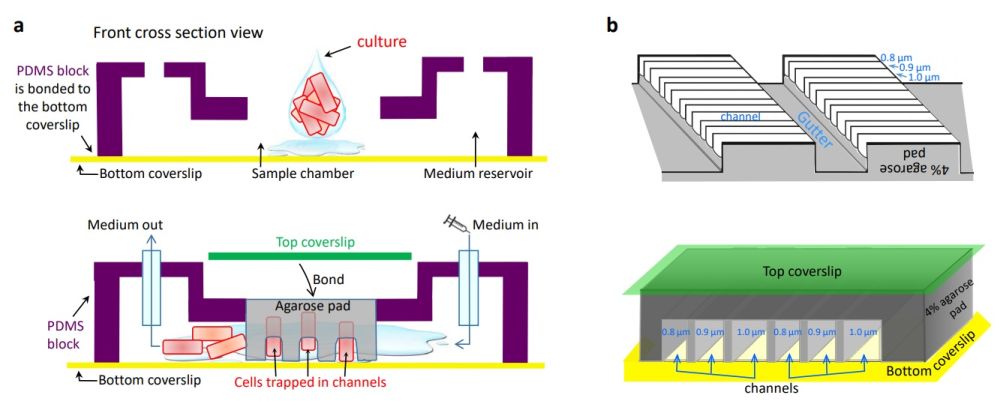
24 Aug Microfluidic device can reveal how primordial cells proliferated
L-form bacteria also known as cell wall deficient (CWD) bacteria are strains with no cell wall developed from initial walled bacteria. Cell walls play an important during the division of the cells. However, since L-form lacks a cell wall, the division is disorganized and daughter cells can have different sizes. The unusual structure and division of these cells can shine a new light on our understanding of the early forms of life.
A new study published in nature communication by a research group in Newcastle University unravels the geometric principles underlying cell proliferation in wall-deficient cells using a microfluidic device.
“We use microfluidic systems to probe the growth, chromosome cycle and division mechanism of Bacillus subtilis L-forms. We find that forcing cells into a narrow linear configuration greatly improves the efficiency of cell growth and chromosome segregation.”, the authors elaborated.
Design and working principle of the chip
The microfluidic chip was made using microfluidic fabrication techniques by creating microchannels of different widths (0.6-2.2 micron) on PDMS. The PDMS was then used as a replica to transfer the pattern onto a 4% agarose. The concentrated L-form bacteria were then added to a microfluidics assembly. The agarose microchannels were placed on the bacteria cells to trap them inside the slits that were 1.6 micron high. The small height of the microchannels allows strong control over the bacteria as they proliferate. The microchannels were connected to orthogonal side channels through which the growth medium flowed.

The microfluidic device used for studying the L-form bacteria. Reproduced under a Creative Commons Attribution 4.0 International License.
The microfluidic device helped to contain the cells in confinements without damaging the cells. The microfluidic slits contained the cells in elongated shape in traps with sizes similar to the walled cells. This elongated form gives the L-form a shape identical to that of the walled cell. Studying the L-form bacteria in these channels will, therefore, reveal whether it is the cell wall or the cell geometry that affect the proliferation.
It was shown that the doubling time of L-form bacteria within the confinements is significantly reduced. The L-form doubled in ~55 minutes which is considerably lower than the 6-8 hours doubling time in unconstrained liquid culture. It was hypothesized then that it is the cell geometry that influences the cell division rather than the cell wall. It is an important discovery since it can omit the theories regarding the role of the cell wall in chromosome segregation.
“Our results emphasise the importance of geometric effects for a range of crucial cell functions, and are of relevance for efforts to develop artificial or minimal cell systems”.
Read the original article: Geometric principles underlying the proliferation of a model cell system

Pouriya Bayat
Pouriya is a microfluidic production engineer at uFluidix. He received his B.Sc. and M.A.Sc. both in Mechanical Engineering from Isfahan University of Technology and York University, respectively. During his master's studies, he had the chance to learn the foundations of microfluidic technology at ACUTE Lab where he focused on designing microfluidic platforms for cell washing and isolation. Upon graduation, he joined uFluidix to even further enjoy designing, manufacturing, and experimenting with microfluidic chips. In his free time, you might find him reading a psychology/philosophy/fantasy book while refilling his coffee every half an hour. Is there a must-read book in your mind, do not hesitate to hit him up with your to-read list.


